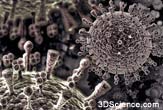Natural Body Guards: How Your Killer Cells Get Motivated

Natural killer cells form the body's front line of defense. When viruses and cancers attack, the cells keep the invaders at bay while the rest of the immune system prepares.
Unlike our other immune cells, natural killer cells are always at the ready. They have an innate ability to recognize viruses and tumor cells, while other disease-fighting cells take precious time—two to three days—to build forces and learn what the enemy looks like.
Originally named for their apparent belligerency at birth, scientists have found that even natural killer cells need help maturing into warriors.
Killer Instinct
Researchers from the Salk Institute for Biological Studies and the Pasteur Institute in Paris recently discovered the molecular signals that spark this killer instinct.
- How Flies Walk on Ceilings
- How Viruses Invade Us
- All About Genes
- How We Smell
- Why We Lie
- Why Ants Rule the World
- The Science of Traffic Jams
- Why Rice Krispies Go Snap, Crackle, Pop!
- The Shocking Truth Behind Static Electricity
- Why the Ground is Brown
- Why Frogs are Green
- How Dolphins Spin, and Why
"We've known these receptors work in other cells in the immune system," said neurobiologist Greg Lemke of the Salk Institute. "But we had no idea it had anything to do with natural killer cells."
The findings were published in the June 4 online issue of the journal Nature Immunology.
Sign up for the Live Science daily newsletter now
Get the world’s most fascinating discoveries delivered straight to your inbox.
In our bone marrow, the body is constantly making new natural killer cells, which are a type of white blood cell defenders called lymphocytes. The small cells make up a large portion of the body's fortification; 10 to 15 percent of all lymphocytes are natural killer cells.
Inside each cell is an arsenal of lethal weapons. The cells patrol the body, searching for signs of infected or cancerous cells.
Once a natural killer cell recognizes a foe, it cuts open the cell and floods it with deadly enzymes. At the same time, the killer releases chemicals that signal the immune system to produce B and T cells, the second line of defense.
However, without the receptors that kick the first responders into gear, the armed cells never become combat-ready.
"When they see a target cell, they don't do anything," Lemke told LiveScience. "They're poor killers."
Harnessing the power
Mice missing the receptors grow sick and become prone to infections. But when immature cells are given the protein receptors, the natural killers start to recognize and respond to infected cells.
"The proteins we've identified are very efficient [at stimulating mature natural killer cells] in the mouse and cell culture," Lemke said. "If those worked in humans, we could, down the line, treat people."
In the future, immunologists might find a way to give these proteins to cancer patients and those suffering from autoimmune diseases, to jumpstart their natural killer cell firing squad and ramp up their immune systems.










